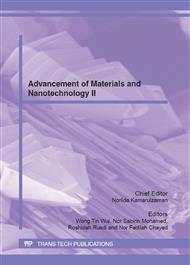[1]
R.C. Garvie, R.H. Hannink and R.T. Pascoe: Ceramic Steel? Nature, (1975), pp.703-704.
DOI: 10.1038/258703a0
Google Scholar
[2]
T. Masaki: Journal of American Ceramic Society (1986), 69: 638 - 640.
Google Scholar
[3]
K. Tsukuma, Y. Kubota, and T. TSukidata in: Science and Technology of Zirconia, The American Ceramic Society, Columbus, pp.465-479.
Google Scholar
[4]
B.A. Cottom, M.J. Mayo: Scripta Matter, (1996), 34: 809 - 814.
Google Scholar
[5]
S. Ran, L. Winnubst, W. Wiratha and D.H.A. Blank: Journal of American Ceramic Society (2006), 89: 151 - 155.
DOI: 10.1111/j.1551-2916.2005.00679.x
Google Scholar
[6]
P. Bowen, C. Carry in: From powdered to sintered pieces: Formation, transformation and sintering of nanostrucutred ceramic oxides, Powder Technology, 128: p.248 – 255.
DOI: 10.1016/s0032-5910(02)00183-3
Google Scholar
[7]
J. Wang, L. Gao: Photoluminesence properties of nanocrytalline ZnO ceramics prepared by presureless sintering and spark plasma sintering, Jounal of American Ceramic Society (2005), 88: 1637 – 1639.
DOI: 10.1111/j.1551-2916.2005.00259.x
Google Scholar
[8]
A. Weibel, R. Bouchet, R. Denoyel and P. Knauth: Hot pressing of nanocrystalline TiO2 (anatase) ceramics with controlled microstructure. Journal of European Ceramic Society (2007), 27: 2641-2646.
DOI: 10.1016/j.jeurceramsoc.2006.11.073
Google Scholar
[9]
B. Basu, J. Lee, and D.Y. Kim: Development of nanocrytalloine wear – resistant Y-TZP ceramics. J. Am. Ceram. Soc, (2004) 87: 1771-1774.
DOI: 10.1111/j.1551-2916.2004.01771.x
Google Scholar
[10]
R.S. Dobedoe, G.D. West, and M.H. Lewis: Spark plasma sintering of ceramics. Bulletin of the European Ceramic Society (2003), 1: 19-24.
Google Scholar
[11]
M. Mazaheri, A. Simchi, and F. Golestani-Fard: Densification and grain growth of nano crystalline 3YTZP during two step sintering. Ceramics International (2008), 35: 547-554.
DOI: 10.1016/j.jeurceramsoc.2008.04.030
Google Scholar
[12]
R.L. Coble, R.M. Cannon: Processing of crystalline ceramics. Materials science Research (1978), vol. 11, Plenum, New York, pp.151-168.
Google Scholar
[13]
P.L. Chen and I.W. Chen: Sintering of fine oxide powders. II. Sintering mechanisms. Jounal of the American Ceramic Society (1997), 80: pp.637-645.
DOI: 10.1111/j.1151-2916.1997.tb02879.x
Google Scholar
[14]
I.W. Chen, and X.H. Wang: Sintering densed nanocrystalline ceramics without final stage grain growth. Nature (2000), 404: pp.168-171.
DOI: 10.1038/35004548
Google Scholar
[15]
X.H. Wang, X.Y. Deng, H.L. Bai, H. Zhou, W.G. Qu and L.T. Li:. Two step sintering of ceramics with constant grain size, II: BaTiO3 and Ni-Cu-Zn ferrite. Journal of the American Ceramic Society (2006). 90: pp.438-443.
DOI: 10.1111/j.1551-2916.2005.00728.x
Google Scholar
[16]
K. Bodisova, and P. Sajgalik: Two stage sintering of alumina with submicron grain size. Jounal of the American Ceramic Society (2007), 90: pp.330-332.
Google Scholar
[17]
A. Ghosh, A. Suri, B.T. Rao, and T.R. Ramamohan: Low Temperature Sintering and mechanical property evaluation of nanocrystalline 8 mol% yttria fully stabilized zirconia. Journal of the American Ceramic Society (2007), 90: p.2015 – (2023).
DOI: 10.1111/j.1551-2916.2007.01683.x
Google Scholar
[18]
M.N. Rahaman, Sintering technology, Sintering and Grain growth of ultrafine ceramics powder (1991). New York: Markel Dekker.
Google Scholar
[19]
M.N. Rahaman: Ceramic Processing and Sintering (2003), 2nd Edition , New York:. Marcel Dekker.
Google Scholar
[20]
J. Li, Z. Tang, Z. Zhang, and S. Luo: (2003). Study of factors influencing the microstructure and phase content of ultrafine Y-TZP. Material Science and Engineering (2003), 99: pp.321-324.
DOI: 10.1016/s0921-5107(02)00563-9
Google Scholar


